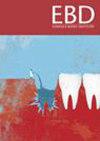Can caries in anterior teeth of toddlers predict severe caries in posterior teeth?
Q3 Dentistry
引用次数: 0
Abstract
Tavares B S, Bendo C B, Fernandes I B, Coelho V S, Ramos-Jorge M L, Ramos-Jorge J Dental caries in anterior teeth of babies can predict the occurrence of severe dental caries in posterior teeth: a 3-year cohort study. Eur Arch Paediatr Dent 2024; https://doi.org/10.1007/s40368-024-00968-6 . A three-year study of 1–2 years old toddlers to check if the dental caries of primary anterior teeth is a precursor to them developing severe caries on their primary molars. A cohort of 99 children, between the ages of 1–2 years old, reviewed for dental caries. This study looked at the toddlers at the baseline and then reviewed them after three years. Primary independent variable in this study was carious anterior tooth. Consideration given to independent variables like economic status, primary carers’ education, oral hygiene (including nighttime routine), history of tooth ache, and sucrose intake. Differences between the presence and absence of severe dental caries in posterior teeth according to independent variables were evaluated using the chi-square test. Unadjusted and adjusted relative risks for the association between independent variables and the incidence of severe caries in posterior teeth were estimated using Poisson regression models with robust variance. There is threefold increased risk of developing severe dental caries in posterior teeth for the children who had caries in anterior teeth at the baseline (RR 3.33; 95% CI 2.06–5.37). This high-risk group belonged to low-income families (RR 2.75; 95% CI 1.40–5.39), who did not perform nighttime oral hygiene (RR 1.76; 95% CI 1.10–2.80), and had a higher frequency of sucrose intake (RR 4.07; 95% CI 2.03–8.19), at the baseline and at follow-up. The presence of dental caries in the primary anterior teeth of 1 to 2-year-old toddlers can have a higher incidence of severe caries in posterior teeth. Other factors e.g. low economic status, absence of nighttime oral hygiene, high sucrose intake both at baseline and follow-up were considerable risk factors for the presence of severe dental caries in the primary posterior teeth.求助全文
约1分钟内获得全文
求助全文
来源期刊

Evidence-based dentistry
Dentistry-Dentistry (all)
CiteScore
2.50
自引率
0.00%
发文量
77
期刊介绍:
Evidence-Based Dentistry delivers the best available evidence on the latest developments in oral health. We evaluate the evidence and provide guidance concerning the value of the author''s conclusions. We keep dentistry up to date with new approaches, exploring a wide range of the latest developments through an accessible expert commentary. Original papers and relevant publications are condensed into digestible summaries, drawing attention to the current methods and findings. We are a central resource for the most cutting edge and relevant issues concerning the evidence-based approach in dentistry today. Evidence-Based Dentistry is published by Springer Nature on behalf of the British Dental Association.
 求助内容:
求助内容: 应助结果提醒方式:
应助结果提醒方式:


